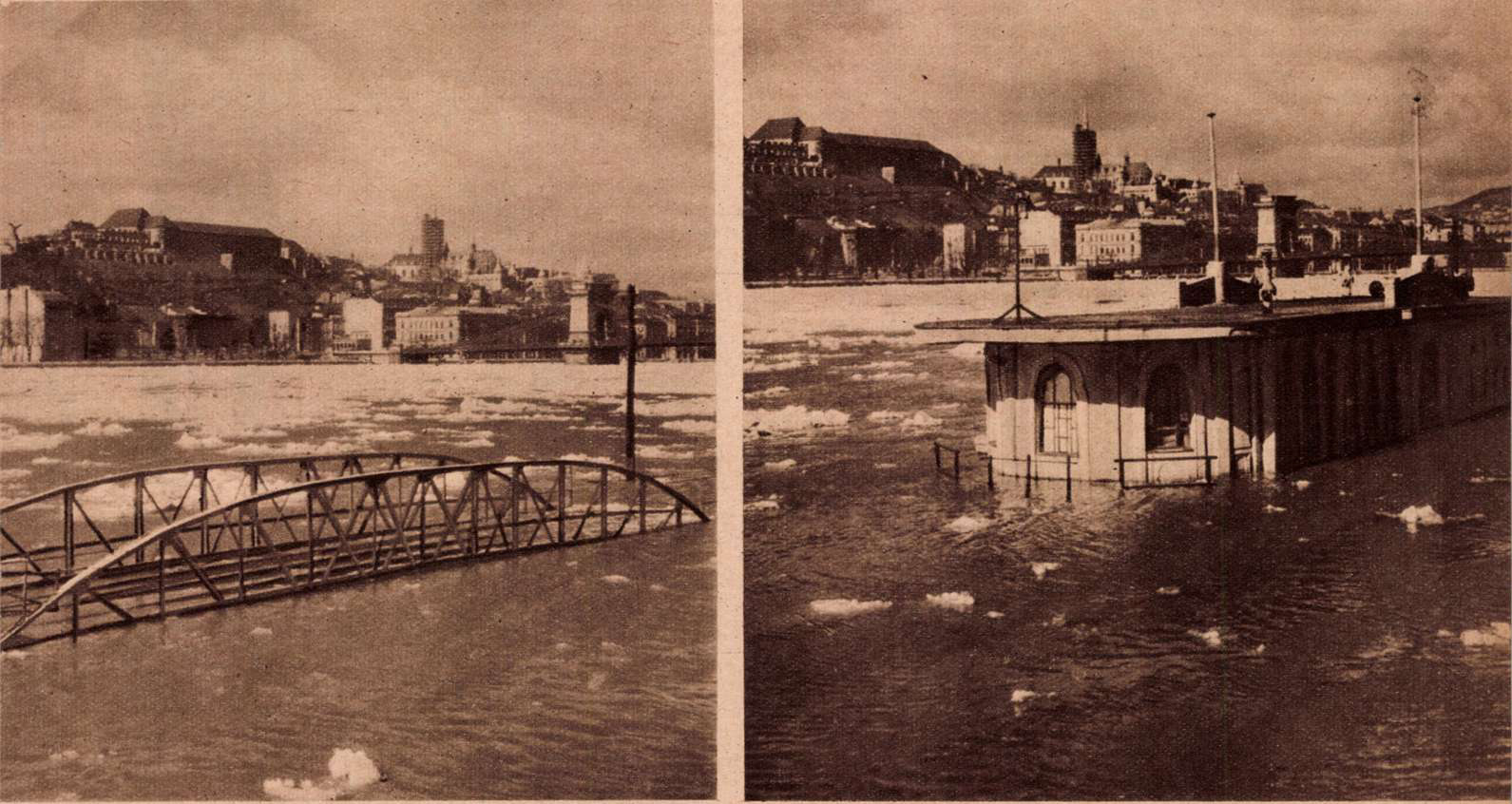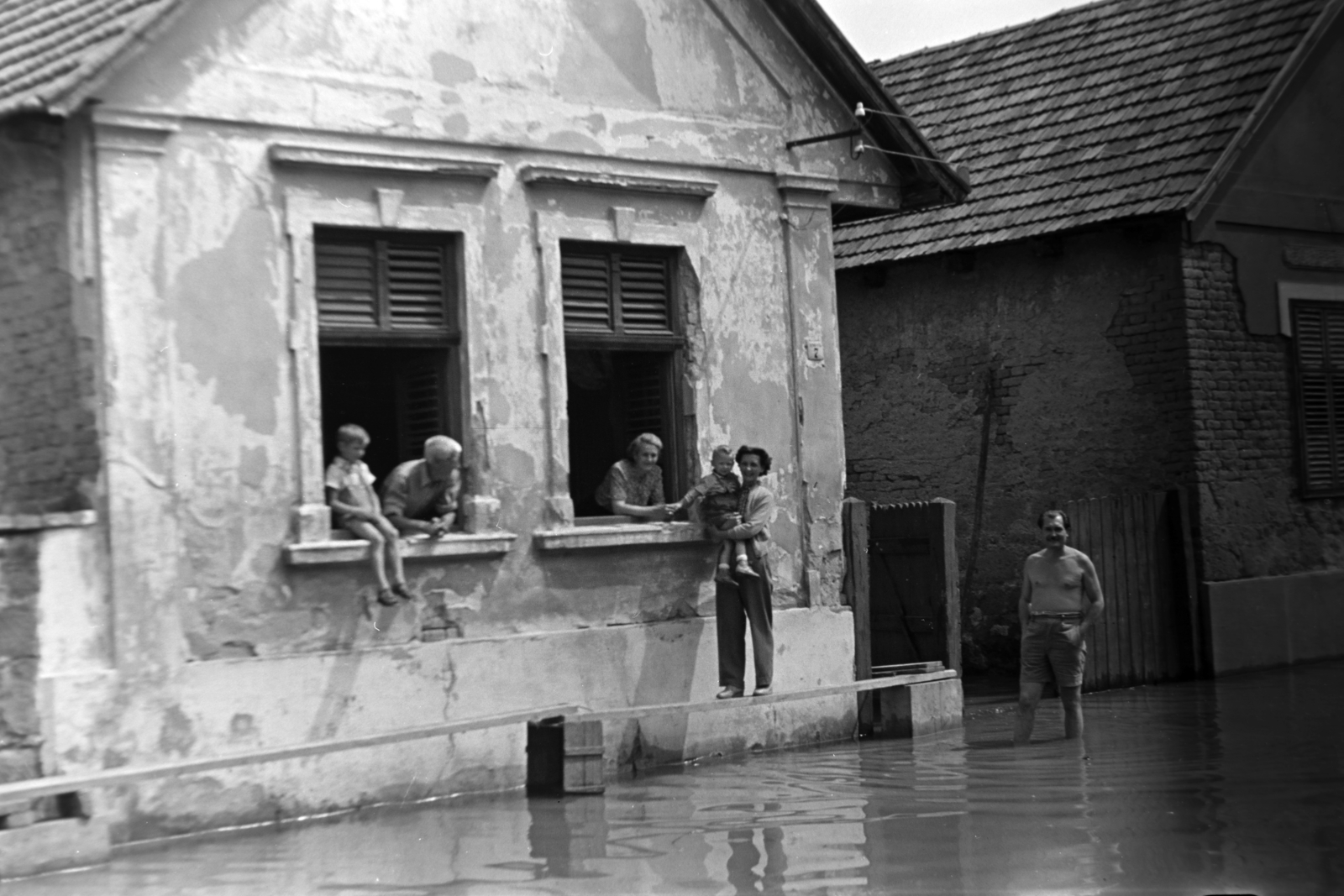The 1956 ice flows brought a massive bod of water down the Danube It caused most damage south of Budapest, in Mohács and especially Baja. In several places, the army was forced to attack the ice: several bombs were dropped and controlled explosions carried out, including one near Kossuth Bridge in Budapest.
For all sense and purposes, Budapest is practically flood-proof. The amount of water needed to truly endanger the city is enormous. Its defences are well-built, and its specialists well-prepared, as has been the case since the 19th century.
Yet, the great flood required special measures from the professionals of the time. The winter of 1955–1956 was cold. Not only in Hungary. Snowfall was high in the entire Danube catchment area. The end of the winter was very cold, and the heat came quickly. On 29 February 1956, the temperature jumped 10 degrees in Budapest in half a day, and the on average 43 cm deep snow began to melt quickly.

It is clear how high the water level was on 6 March 1956 before the ice barriers at Kossuth Bridge were blown up (Source: Béke és Szabadság weekly, 7 March 1956)
Ice began flowing on the Danube, but the flowing ice dammed the river south of Ercsi. Later an ice plug formed near Dunaföldvár, even though specialists were prepared for the situation.
Szabad Nép reported on the preparations for a flood on 8 March 1956:
“Budapest is prepared for a rise in water levels. In the late evening on Wednesday, we walked along both banks of the Danube in Budapest. Around ten o'clock, both banks of the Danube were quiet, there was hardly any ice on the Danube, only the water level was unusually high. Four riverboats were stranded near Stalin Bridge (Árpád Bridge - DCS), which were unable to pass under the bridge due to the high water level. On Rómaipart a few cabins were underwater, but only in the lowest-lying parts.
Although the water was nowhere near the height of the dams and embankments emergency dams have been built in several areas. A one-hundred strong team is ready in the Óbuda Shipyard to take immediate and effective action in the event of the slightest disruption.”
At the same time, other steps were taken against the flood. On 7 March, the Budapest Flood Protection Committee was created, pumps were installed on the Nagytétény section of the river, and the floodwalls were closed on Római-part

Tabán in early 1956. The winter of 1955–1956 was icy. Over 32 centimetres of snow covered Budapest (Photo: Fortepan/No: 148429)
The biggest danger was ice dams forming along the river. Most bridges in Budapest were built to allow for ice to flow between their pillars freely, but not all.
Controlled explosions prevented the formation of ice dams on the Budapest section of the Danube. On 5 March 1956, the explosives and demolitions specialists of Hídépítő Vállalat (Bridge Construction Company) prepared blasts near the pillars of Kossuth Bridge.

The moment of the blast at Kossuth Bridge in Budapest in a contemporary photograph in the 7 March 1956 issue of the weekly Béke és Szabadság.
The problem was that the bridge between Batthyány Square and Kossuth Square – built extremely quickly in 1945–1946 – had 8 pillars on which the ice became stuck. Ice dams began forming to the north of the bridge. One 80 metres wide and 300 metres long formed closer to Pest, while another near the Buda bridgehead was smaller, only 50 by 100 metres, but thicker.
The two ice blocks were blown up to allow the ice to flow down the river freely. Explosions were carried out on the southern stretches of the Danube as well, and in places, the army was forced to bomb the ice dams. The ice barriers to the south of Budapest were potentially dangerous for the city, so the army was deployed. On 7 March 1956, Népszava wrote:
“The rapid rise of the water level caused by an ice dam on the section of the river below Budapest from Lórév-Makád to Ercsi, made it necessary to deploy the air force to break up the ice blocks over 39 kilometres of the river. From 1 o'clock in the afternoon, the Air Force will again bomb the ice in the Rácalmás area to create a pathway for ice to flow down the river.”
As a result of the bombing, the water started moving again, and the water level dropped 98 centimetres at Ercsi and 18 centimetres in Budapest. Later, however, a more significant ice plug developed at Dunaföldvár, which was removed by bombing and controlled blasts.

The water reached the bottom steps of the Parliament building (right), construction of emergence dam (left) (Source: Béke és Szabadság, 7 March 1956)
The idea of explosive flood protection was not new. During the 1838 flood, an attempt was made to break the ice plug formed at Lágymányos with cannon fire. Controlled ice blasting was first used in Hungary during the 1876 floods.
The flood wreaked havoc around Baja, one-third of the city was submerged, and dams broke in several places. However, Budapest did not survive untouched either. The Danube attacked Soroksár and Csepel through the Soroksár branch of the Danube. The flood and ice destroyed the Tassi sluice; this allowed the river to flood back into its side-branch. While this was not a problem for most of Budapest, the lower, unprotected parts of Csepel, Soroksár and Pesterzsébet were flooded. A total of 33 houses collapsed, and 561 became uninhabitable.

Flooded house along the Danube in 1956 (Photo: Fortepan/No.: 191926)
As a result of the events, flood prevention systems along the Danube were developed further. The decision to build a fleet of Danube ice breakers was also reached, as no such boats had been used on the Danube in Hungary before then.
Cover photo: Ice flows on the Danube (Photo: Fortepan/No.: 13002)





































Hozzászólások
Log in or register to comment!
Login Registration